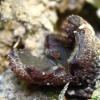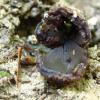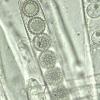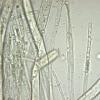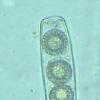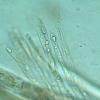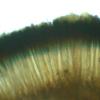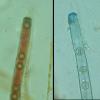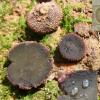
28-12-2025 12:08
Margot en Geert VullingsThis possible Karstenia was found on the bark of d

21-12-2025 21:32
Pol DebaenstHello, Garden, Burgweg 19, Veurne, BelgiumOn 10/1

26-12-2025 21:19
Arnold BüschlenPithyella chalaudii Priou. Ist als Bryoparasit in

21-12-2025 09:32
Hello.A tiny ascomycete found embedded in wood in

18-12-2025 21:17
Pol DebaenstThe identification took me to Byssonectria deformi

24-12-2025 17:08
Hulda Caroline HolteHello, I have found this propoloid ascomycete on
Marcelleina?
Martin Bemmann,
04-08-2009 10:49
 Dear all,
Dear all,my colleague Ditte found this small broken cup on bare soil on a shady slope. After going through Boudier's plates and consulting the article of Moravec (Mycotoxon 30, 1987, 473-499) we came into consent that this could be a Marcelleina (brevicostatispora?).
Can this be confirmed?
Best regards,
Martin
Pascal RIBOLLET,
04-08-2009 13:27
Re:Marcelleina?
Why not Scabropezia sp.? The resemblance is striking (greenish shade of apothecia, external surface strongly warted). I find S. scabrosa in western France (Loire Atlantique) on the river banks, it looks exactly like that. It could also be S. flavovirens...
The spores could fit with the genus Scabropezia too.
Are the asci IKI+ ? This is the case for Scabropezia (Pezizaceae) but not Marcelleina (Pyronemataceae).
Best regards
Pascal Ribollet
The spores could fit with the genus Scabropezia too.
Are the asci IKI+ ? This is the case for Scabropezia (Pezizaceae) but not Marcelleina (Pyronemataceae).
Best regards
Pascal Ribollet
Martin Bemmann,
04-08-2009 21:26

Re:Marcelleina?
Hi Pascal,
yes quite convincing! We didn't know this genus, yet.
I forwarded to her to do this IKI-job.
Regards, Martin
yes quite convincing! We didn't know this genus, yet.
I forwarded to her to do this IKI-job.
Regards, Martin
Martin Bemmann,
05-08-2009 21:53

Re:Marcelleina?
Hi Pascal,
Ditte gave me some leftover crumbles of this cup and left the "IKI-job" for me ;-)
Well, I did a new preparation showing you in the next pictures the asci with spores, paraphyses, that are filiforme and not clavate (as in Saccardo's diagnosis of Phaeopezia scabrosa) and the positive reaction of the asci in IKI, especially good visible at immature asci.
We owe you the measurements of the spores as well. I didn't find any free ones, as Ditte didn't. But those developed ones inside the asci measured 14,1-15,4 µm (perfect for P. scabrosa).
Now I have a problem with my data: spore size is OK but shape of the paraphyses not. Saccardos P. atro-spora has filiforme paraphyses but much larger spores (18-20 µm).
I don't have any more recent description of this genus at hand.
Can you help?
Best regards,
Martin
Ditte gave me some leftover crumbles of this cup and left the "IKI-job" for me ;-)
Well, I did a new preparation showing you in the next pictures the asci with spores, paraphyses, that are filiforme and not clavate (as in Saccardo's diagnosis of Phaeopezia scabrosa) and the positive reaction of the asci in IKI, especially good visible at immature asci.
We owe you the measurements of the spores as well. I didn't find any free ones, as Ditte didn't. But those developed ones inside the asci measured 14,1-15,4 µm (perfect for P. scabrosa).
Now I have a problem with my data: spore size is OK but shape of the paraphyses not. Saccardos P. atro-spora has filiforme paraphyses but much larger spores (18-20 µm).
I don't have any more recent description of this genus at hand.
Can you help?
Best regards,
Martin
Pascal RIBOLLET,
07-08-2009 13:49
Re:Marcelleina?
Hi Martin,
So it seems that Scabropezia is confirmed.
I know few reference about that species :
- Bull. de la Fédération Myc. et Bot. du Dauphiné-Savoie 183 p.11-24
- Nordic Macromycetes vol. 1 p.66
- Danish keys at the Mycokey site (open the big key "Asconoegle.pdf", pages 45 and 47).
That's all I have.
My personal data : spores 13,5-15 µm diameter, without ornementations (truncate warts 1-1,5 µm).
But just as you, I did not find perfectly mature spores. Perhaps that can explain the difference with Saccardo's measures (18-20 µ...ornemenation included ?).
On you first picture, the warts seems to be a bit lower than in my collection (see attached picture)...Anyway I suppose that your find could be S.scabrosa and not flavovirens, because of the coarse warts and the lack of yellowish tinge (according to danish key).
Martin, did you see any latex seeping out of the apothecia ? It is the case for my collection, but I can't find it mentionned in the literature.
Best regards
Pascal
So it seems that Scabropezia is confirmed.
I know few reference about that species :
- Bull. de la Fédération Myc. et Bot. du Dauphiné-Savoie 183 p.11-24
- Nordic Macromycetes vol. 1 p.66
- Danish keys at the Mycokey site (open the big key "Asconoegle.pdf", pages 45 and 47).
That's all I have.
My personal data : spores 13,5-15 µm diameter, without ornementations (truncate warts 1-1,5 µm).
But just as you, I did not find perfectly mature spores. Perhaps that can explain the difference with Saccardo's measures (18-20 µ...ornemenation included ?).
On you first picture, the warts seems to be a bit lower than in my collection (see attached picture)...Anyway I suppose that your find could be S.scabrosa and not flavovirens, because of the coarse warts and the lack of yellowish tinge (according to danish key).
Martin, did you see any latex seeping out of the apothecia ? It is the case for my collection, but I can't find it mentionned in the literature.
Best regards
Pascal
Martin Bemmann,
07-08-2009 16:03

Scabropezia!
Hi Pascal,
Yes, Scabropezia! And thanks for the references! We should add the original article of Dissing/Pfister, Scabropezia, a new genus of Pezizaceae (Pezizales), Nordic Journal of Botany 1, 1981, 102-108. Sadly I have no access to this article since my university library has no e-abonnement of this journal.
Saccardo gives these large measurings not for P. scabrosa (15 µm), but for P. atro-spora. The Danish key of Westerholt/Petersen gives 14-15,5 µm. This fits all very well. To decide whether the warts are coarse or not, one has to see both possibilities which I didn't. By the way, you don't have a picture of the paraphyses of your find, by chance?
This latex drops were absent at Dittes find. Are you sure it is oozing out from the hymenium or could it be an external contamination? Did you look into it with the microscope?
All the best,
Martin
Yes, Scabropezia! And thanks for the references! We should add the original article of Dissing/Pfister, Scabropezia, a new genus of Pezizaceae (Pezizales), Nordic Journal of Botany 1, 1981, 102-108. Sadly I have no access to this article since my university library has no e-abonnement of this journal.
Saccardo gives these large measurings not for P. scabrosa (15 µm), but for P. atro-spora. The Danish key of Westerholt/Petersen gives 14-15,5 µm. This fits all very well. To decide whether the warts are coarse or not, one has to see both possibilities which I didn't. By the way, you don't have a picture of the paraphyses of your find, by chance?
This latex drops were absent at Dittes find. Are you sure it is oozing out from the hymenium or could it be an external contamination? Did you look into it with the microscope?
All the best,
Martin
Pascal RIBOLLET,
07-08-2009 16:34
Re:Marcelleina?
Thanks for the reference of Nordic Journal of Botany. But I also have no access...
Quite sure for the latex ! in my picture it comes from lancet strokes in the hymenium, photo taken about 2 minuts later.
Cheers
Pascal
Quite sure for the latex ! in my picture it comes from lancet strokes in the hymenium, photo taken about 2 minuts later.
Cheers
Pascal
Martin Bemmann,
07-08-2009 21:14

Re:Marcelleina?
Hi Pascal,
a friend of mine, currently in the US, will send me the Nordic paper in the next days. I will share it with you. How about paraphyses? ;-)
Cheers,
Martin
a friend of mine, currently in the US, will send me the Nordic paper in the next days. I will share it with you. How about paraphyses? ;-)
Cheers,
Martin
Martin Bemmann,
11-08-2009 08:55

Scabropezia flavovirens
Hi,
today I could look into the article by Dissing/Pfister 1981. I am sure the ornamentation of the spores is that of S. flavovirens. S.scabrosa has 1.2-1.8 µm high capitate(!) warts, irregularly outlined.
Best regards, Martin
today I could look into the article by Dissing/Pfister 1981. I am sure the ornamentation of the spores is that of S. flavovirens. S.scabrosa has 1.2-1.8 µm high capitate(!) warts, irregularly outlined.
Best regards, Martin
Pascal RIBOLLET,
12-08-2009 09:28
Re:Marcelleina?
I checked the paraphyses of my collection : they have the same shape as in yours.
250-300 x 8-9 (10) µm, 3-4 septa, roughly straight, not forked, not or slightly (and progressively) enlarged at the tip.
All the best
Pascal
250-300 x 8-9 (10) µm, 3-4 septa, roughly straight, not forked, not or slightly (and progressively) enlarged at the tip.
All the best
Pascal
François Valade,
23-08-2009 21:18

Re:Marcelleina?
Hallo Martin, salut Pascal
I am just back from holidays and see your request. I have this paper in pdf. If you don't alreadt got it, I can send it now. File is about 3 Mb.
François
I am just back from holidays and see your request. I have this paper in pdf. If you don't alreadt got it, I can send it now. File is about 3 Mb.
François
Pascal RIBOLLET,
26-08-2009 14:58
Re:Marcelleina?
Salut François,
Désolé je réagis un peu tard...Merci pour ta proposition mais ça y est, c'est ok.
Amitiés
Pascal
Désolé je réagis un peu tard...Merci pour ta proposition mais ça y est, c'est ok.
Amitiés
Pascal
